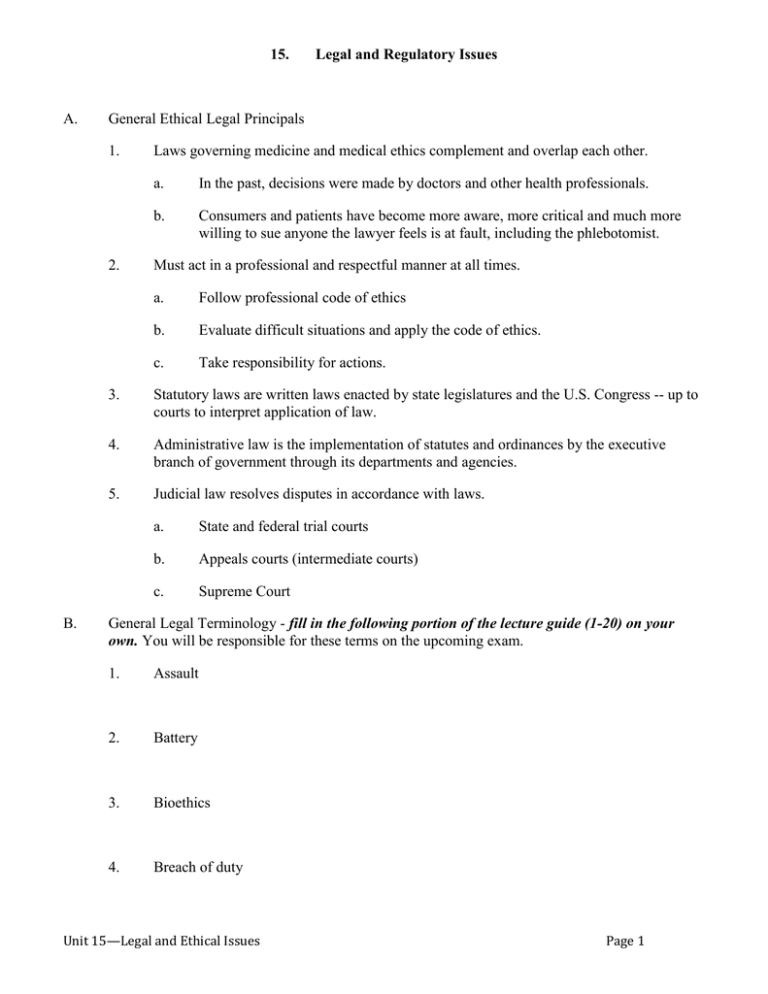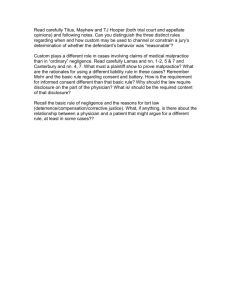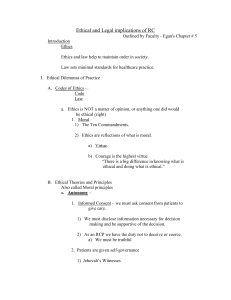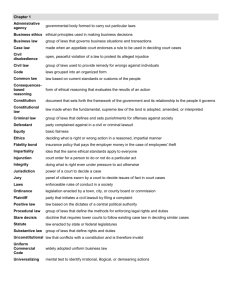Legal and Regulatory Issues
advertisement

15. A. General Ethical Legal Principals 1. 2. B. Legal and Regulatory Issues Laws governing medicine and medical ethics complement and overlap each other. a. In the past, decisions were made by doctors and other health professionals. b. Consumers and patients have become more aware, more critical and much more willing to sue anyone the lawyer feels is at fault, including the phlebotomist. Must act in a professional and respectful manner at all times. a. Follow professional code of ethics b. Evaluate difficult situations and apply the code of ethics. c. Take responsibility for actions. 3. Statutory laws are written laws enacted by state legislatures and the U.S. Congress -- up to courts to interpret application of law. 4. Administrative law is the implementation of statutes and ordinances by the executive branch of government through its departments and agencies. 5. Judicial law resolves disputes in accordance with laws. a. State and federal trial courts b. Appeals courts (intermediate courts) c. Supreme Court General Legal Terminology - fill in the following portion of the lecture guide (1-20) on your own. You will be responsible for these terms on the upcoming exam. 1. Assault 2. Battery 3. Bioethics 4. Breach of duty Unit 15—Legal and Ethical Issues Page 1 5. Civil Law 6. Criminal actions 7. Defendant 8. Ethics 9. False imprisonment 10. Felony 11. Informed consent 12. Invasion of privacy 13. Liable 14. Litigation process 15. Malice 16. Malpractice 17. Misdemeanor 18. Negligence Unit 15—Legal and Ethical Issues Page 2 C. D. 19. Plaintiff 20. Respondeat superior 21. Tort Negligence 1. There has been significant increase over the years in the number of legal cases in which the lab is directly or indirectly involved. 2. Negligence is "violation of duty to exercise reasonable skill and care performing a task". 3. Involves six key points. a. Duty-responsibilities of HCW to patient b. Breach of duty-was duty unavoidably breached c. Foreseeability-certain events may be expected to cause certain outcomes. d. Proximate causation-did breach of duty contribute to or cause injury. e. Injury or harm-demonstration that actual physical injury occurred. f. Damages-patient must show they were actually damaged by negligent act. Patient confidentiality 1. Violation of the right of privacy, another example of negligence. 2. Confidentiality 3. a. No one but the patient may release patient results without a clinical need to know. b. Patient/employee lab results are strictly confidential. Negligence can be sought if employees or patient's drug abuse results are released to anyone but the patient's doctor or authorized individuals. a. Employee or athlete drug or alcohol abuse screening or HIV testing are examples. Unit 15—Legal and Ethical Issues Page 3 b. 4. E. F. G. Confidential materials include: 1) Communications between doctor and patient 2) Patient's verbal statements 3) Non-verbal communications such as lab result HIV status of patient a. Some states do not allow HCWs to know the HIV status of a patient b. In case of accidental needle stick, patient must give consent for testing. Malpractice 1. Defined as improper or unskillful care of a patient by an HCW, or any unreasonable lack of skill or professional misconduct. 2. Relationship between doctor and patient is a contractual one involving the following elements. a. Offer by the physician to provide a service. b. Acceptance by the patient for treatment. c. Consideration-patient accepts treatment and pays for care. 3. Contract implies obligations on both parts. 4. Physicians must provide a standard of care. a. Patient injury during blood collection. b. Patient must prove that HCW failed to follow standard of care. c. Standard of care determined by what a reasonably prudent person would do under similar circumstances. Standard of Care 1. If patient is injured during blood collection must prove that standard of care was not followed. 2. Based on standard practice in the field, what conduct a prudent person would do under similar circumstances. 3. For laboratories this is an expanding area as national standards are set. Informed consent 1. Defininiton-"voluntary permission by a patient to allow touching, examination, and/or treatment by health care providers." Unit 15—Legal and Ethical Issues Page 4 H. I. 2. If patient requires treatment that is of potential risk, the doctor must explain risks and alternatives prior to asking patient to sign informed consent form. 3. Written form is required for surgical, invasive, or experimental procedures. 4. Largest area of litigation -- which is the primary reason the phlebotomist must explain blood collection procedures in simple terms. 5. Special consent for children, unconscious adults or emergency situations. 6. Implied consent exists when immediate action is required to save a patient's life or prevent permanent impairment; “when patient’s nonverbal behavior indicates agreement.” Statute of Limitations 1. Law that defines how soon after injury a plaintiff must file a lawsuit or be forever barred from doing so. 2. Purpose is to prevent threat of lawsuit forever 3. Two year limit in most states for professional negligence 4. Complete and accurate documentation is critical Legal Claims and Defense in Malpractice Suit 1. First pleading filed is complaint-states the cause of the lawsuit 2. Proceeds to discovery-oral testimony from witnesses 3. Deposition-testimony of witness in writing 4. Court orders can be obtained to examine documents pertaining to case. 5. If you are involved in a deposition follow the following guidelines: a. Answer only the questions asked b. Be organized in your recollections c. Do not be antagonistic d. Explain lab/blood collection process in simple terms e. Do not overdramatize the facts f. Dress neatly and groom appropriately g. Be polite, sincere and courteous h. Be sure to ask for clarification on questions you do not understand i. If you are not sure of any answer, indicate that in your response. Unit 15—Legal and Ethical Issues Page 5 6. a. Gives information concerning practices, patterns and levels of skill. b. Patient's expert witness will testify that care was negligent and the standard of care was not provided. 7. Evidence is used to prove or disprove a lawsuit 8. How to avoid a lawsuit 9. J. Expert Witness a. Perform blood collection according to National Standards b. Obtain consent c. Do not violate confidentiality d. Maintain blood collection area with appropriate supplies, especially safety e. Exhibit good listening skills f. Report incidents immediately and document Respondeat superior ("let the master answer") the concept whereby actions of one individual may be imputed to another person having control. a. Holds employers responsible for action of employees b. Employer may be included in lawsuit c. Injured party may sue BOTH the employee and employer Medical Records are vital due to individuals forgetting details as time goes on. 1. Requirements a. Must be neat, legible and accurate. b. Written errors must be corrected properly 1) Never use white out 2) Put one line through error 3) Write correction by it 4) Initial and date the correction c. Computer errors require a specific protocol with electronic documentation. d. Extremely important in malpractice cases. Unit 15—Legal and Ethical Issues Page 6 2. 3. K. a. Allows for continuity of patient care. b. Provides documentation of patient’s illness and treatment. c. Documents communication between doctor and health care team. d. Provides legal documentation that can be used by patient, hospital or health care worker to protect legal interests. Medical records can also be used for non-medical purpose such as billing, utilization reviews, and QI. Cases Resulting From Improper Technique and Negligence 1. 2. L. Serve four purposes: Individuals performing phlebotomy must be thoroughly trained to avoid problems in blood collection arising from: a. Wristband/ID error b. Hematomas c. Abscess at puncture site d. Patient falls e. Fainting f. Nerve damage g. Emotional distress Failure to follow proven or recommended procedures may cause permanent injury to patient resulting in legal action. HIV Related Issues 1. HCW may become infected with HIV during course of performing their duties. 2. Usually covered by workman's compensation benefits. a. Worker must demonstrate causal connection between infection and job b. Always document exposure if it occurs. c. Lifestyle may be investigated 3. May be eligible for unemployment if no longer able to work. 4. POCT testing allows results of HIV testing to be available in 5 minutes. a. Must prepare for ethical and legal implications Unit 15—Legal and Ethical Issues Page 7 M. 2. O. False negatives/positives may occur c. Must inform patient that positive results will have confirmatory test performed. Malpractice Insurance 1. N. b. Blanket Policy used to cover health care staff in hospitals or clinic labs. a. If employed by a pathologist, usually covered under his/her policy. b. Pathologists have lowest premiums because of low risk level. c. Labs rarely named in malpractice suits. d. Lawsuits will go after individuals with money, will look for the “Deep pocket", Considerations when purchasing a. Adequate coverage b. Coverage limitations c. Procedures to follow for coverage to be provided d. Lawyers generally represent employer, may be wise to have own legal counsel. Minimizing Lawsuit Risks 1. Documentation 2. Incident Report 3. Failure to follow published procedures. 4. Failure to ensure patient safety. 5. Improper treatment and/or performance of treatment. 6. Failure to monitor and to report significant changes in patient's condition. 7. Equipment use 8. Patients with communicable diseases or unusual conditions. Clinical Laboratory Improvement Amendment (CLIA) 1. Passed in October 1988; went in affect September 1992. 2. Created to ensure quality and accuracy of laboratory testing. 3. Applies to every clinical laboratory testing facility in the US and requires certification of the lab. Unit 15—Legal and Ethical Issues Page 8 4. Labs performing moderately and highly complex testing are required to undergo inspections. 5. Requires documentation of employees' education, continuing education, and all procedural steps in lab testing. 6. It is important that you have basic knowledge of CLIA 88 as it will have an impact on you in your employment and tests that you can and cannot perform. Unit 15—Legal and Ethical Issues Page 9





